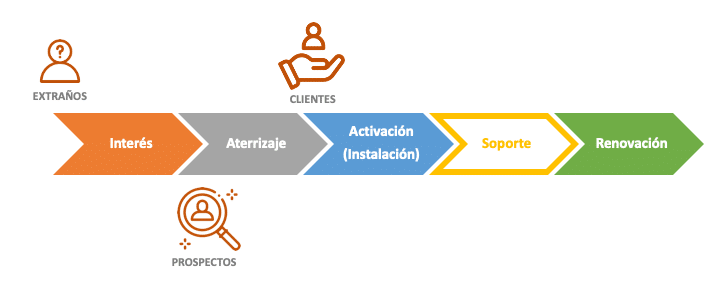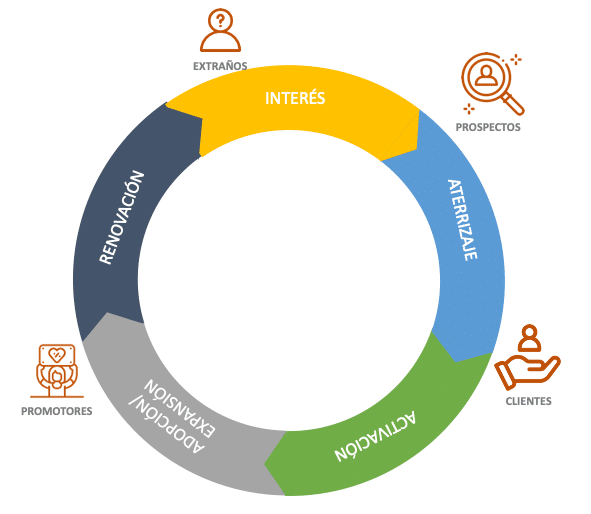En un mundo donde cada vez más los servicios están substituyendo a los productos, es importante entender el rol que juega la atención al cliente y cómo esta puede afectar el ritmo de atrición de los usuarios. En el universo XaaS, donde cualquier cosa se ofrece en una modalidad de pago mensual, la única métrica que importa en realidad para medir el desempeño de una empresa, es la tasa neta de crecimiento de una cuenta, o del agregado de todas las cuentas. Otras métricas como por ejemplo el volumen de ventas, pasan a segundo plano.
Parafraseando lo obvio, si una empresa basada en un régimen de subscripción va adquiriendo nuevos clientes (vendiendo), pero a su vez va perdiendo clientes (atrición) con una velocidad mayor, se estará contrayendo. Los modelos tradicionales de ventas generalmente ignoran esta dinámica.
EL RECORRIDO DEL CLIENTE EN PRODUCTOS TRADICIONALES
En un modelo tradicional del recorrido del cliente, generalmente se representa de una forma lineal. Los clientes se encuentran con las soluciones de la empresa y se hacen de su conocimiento a través de los esfuerzos de mercadotecnia de la empresa. Inmediatamente, el equipo de ventas aborda al cliente para verificar el interés y si la solución encaja dentro de las necesidades del cliente, y éste decide comprar, pues se cierra la transacción y se pasa a la fase de instalación y activación.
Es así como los clientes pasan de ser extraños, a prospectos, y finalmente se convierten realmente en clientes de la empresa.

Una vez que la venta se haya consumado y el producto se entrega, la empresa generalmente interactúa poco con el cliente y sólo se involucra si se manifiesta algún problema, o una vez que el cliente decida refrescar su solución.
UN MODELO DIFERENTE PARA EL RECORRIDO DEL CLIENTE
Hay dos diferencias básicas muy importantes con el modelo anterior en el mundo de los servicios, o “as a service”.
La primera es que el cliente es capaz de cancelar el servicio en cualquier momento. Cierto, en muchas ocasiones hay cláusulas de cancelación temprana, pero la idea es la misma. Una vez que el período cautivo acaba, el cliente puede prescindir de los servicios. Esto por lo general ocurre porque el cliente no está utilizando la solución a cabalidad y -como decimos- no está “extrayendo el valor total” de la solución. En una gran mayoría de los casos esto ocurre por una pobre adopción de la solución dentro de la organización del cliente. Es lógico que el cliente termine por cancelar el servicio si no está utilizando la solución.
La segunda diferencia es que si el cliente atraviesa un ciclo estelar de adopción, por lo general también descubre nuevos usos para la solución, y también agrega más usuarios a la misma.
Estas particularidades son las que le dan origen a un nuevo paradigma del recorrido del cliente, y en particular hablamos del modelo LAER (por sus siglas en Inglés), que vendría siendo algo como:
LAND=ATERRIZAJE
ADOPT=ADOPCIÓN
EXPAND=EXPANSIÓN
RENEW=RENOVACIÓN

Acabamos de discutir brevemente la Adopción y la Expansión. El Aterrizaje se refiere a la venta inicial, cuando “aterrizamos” en una cuenta, y la Renovación, pues obviamente es cuando se restablece el compromiso de continuar en la relación comercial. Es importante señalar, que estos ciclos se pueden hacer tan rápidos y granulares como se desee. De hecho, técnicamente en muchas soluciones XaaS, el ciclo de renovación ocurre en períodos de un mes.
La importancia en adoptar este modelo radica en el hecho de que TODAS las etapas pueden afectar de manera positiva o negativa el volumen de negocios de la empresa. Sólo como ejemplo, es posible aumentar los ingresos, Aterrizando mas clientes, haciendo que un cliente nuevo Adopte mejor la solución, o que uno existente Expanda el uso de la solución y Renueve.
Este modelo lo encuentro útil no sólo para utilizarlo en el contexto de servicios de tecnología, sino también en cualquier escenario donde hay un servicio que es contratado en un modelo recurrente. Por supuesto que en estos incluyo servicios como Spotify o Netflix, donde un ejemplo de adopción adecuada podría ser el haber configurado de manera adecuada los “playlists”, a fin de que pueda escuchar o ver el contenido que me agrada; pero el modelo también se extiende a otras áreas: el pago de alquiler, el seguro de salud, la membresía del gimnasio, los pagos de condominio, e inclusive el pago de impuestos a la propiedad.
EL VERDADERO ROL DE LA GESTIÓN ÉXITO DEL CLIENTE (CUSTOMER SUCCESS)
Una de las razones principales que me motivó a escribir este artículo, es haber visto como los términos de “Éxito del Cliente”, “Atención al Cliente”, y hasta “Soporte” se utilizan de manera intercambiable, y lamentablemente incorrecta; muchas veces por las mismas personas responsables en implementar estos procesos.
Para el momento en que escribo esto, el término “Exito del Cliente” ni siquiera está definido en Wikipedia, pero -creo yo- una buena aproximación es que es una metodología que persigue que los clientes alcancen los resultados deseados mientras utilizan nuestra solución. ALCANCEN LOS RESULTADOS.
Y aquí es donde se define la diferencia fundamental entre una disciplina de soporte y la del Exito del Cliente. En una forma tradicional de Satisfacción del Cliente o de Soporte Técnico, el objetivo es asegurarse que la solución esté funcionando de la forma en que se prometió. En este sentido, muchas veces era aceptable que el departamento de Servicio Técnico pronunciara -palabras más, palabras menos- un odioso: “la solución está diseñada para que funcione así, es Ud. Sra. (o Sr.) cliente quien lo está utilizando mal”. Aquí nació la frase del “Error de capa 8”, refiriéndose de forma cínica al usuario, quien está por arriba de la capa 7 (aplicativo) del modelo OSI.
En contraste, cuando hablamos de Exito del Cliente (y espero que vaya a quedar en evidencia cómo es más importante que nunca), no sólo debemos de asegurarnos que la solución esté funcionando como se prometió, sino que el usuario la esté utilizando como debe ser, y más aún, que la esté utilizando a todo su potencial. En este sentido y bajo el modelo LAER, se vuelve importantísimo que el cliente no solo compre la solución, sino que la implemente como debe ser, que la utilice de manera confiada, que busque utilizar todas sus funcionalidades y que finalmente la recomiende para ser usada en otras áreas de la empresa y por mas usuarios finales.
En fin, el objetivo es que el cliente esté recibiendo el máximo valor de la solución y con ello la adopte, expanda su uso, y la renueve.
En el mundo de todo-como-servicio, por supuesto que es importantísimo implementar otras iniciativas más asociadas al Aterrizaje (Land) -entre ellas el ajuste a los planes de compensación de ventas para hacerlo más atractivo y responsabilizar a ventas parcialmente por la retención de clientes; el aumento de la velocidad en el volante de inercia del proceso de marketing y ventas a fin de adecuarse a transacciones más pequeñas; y la automatización de procesos de provisionamiento y facturación para poderlo hacer de forma repetida y fluida- pero el rol de Soporte y de la Gestión del Éxito del Cliente es fundamental para hacerle frente al reto del resto del modelo -AER-, en la adopción, expansión y renovación; y requiere redefinir las metas y las métricas que persiguen estos departamentos.
Todo porque ahora, la “Capa 8”, es ahora también nuestro problema.